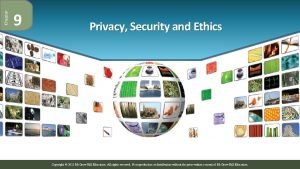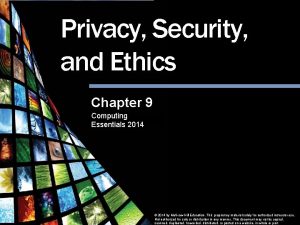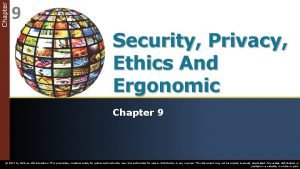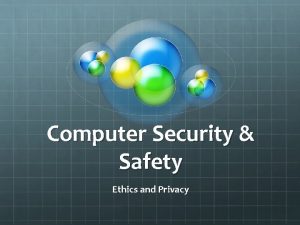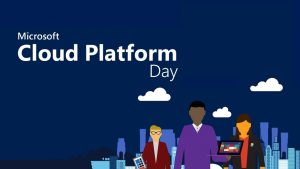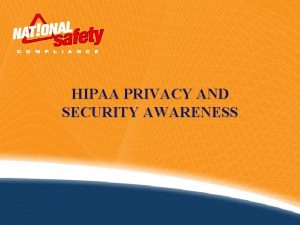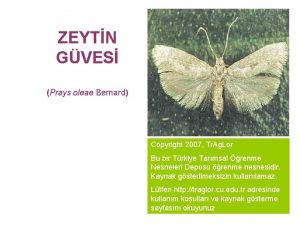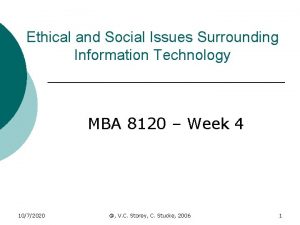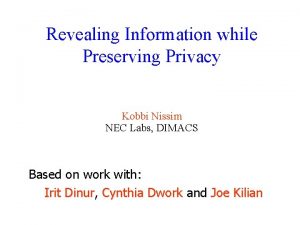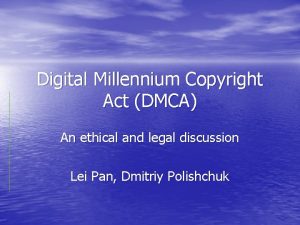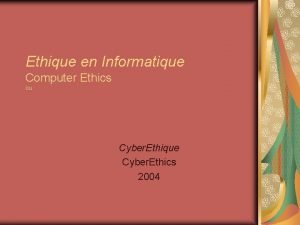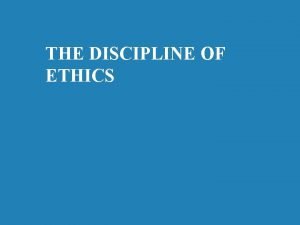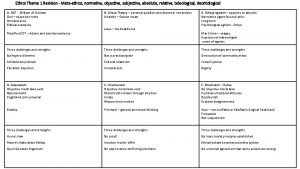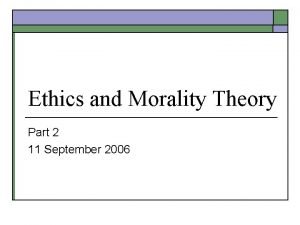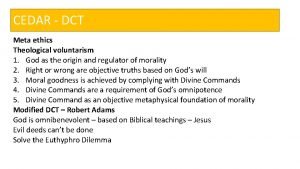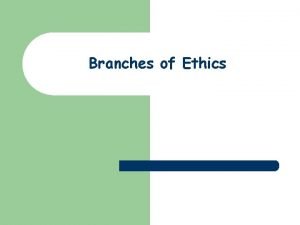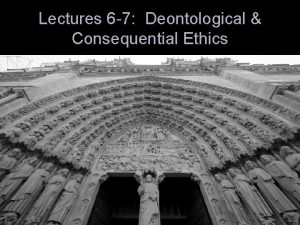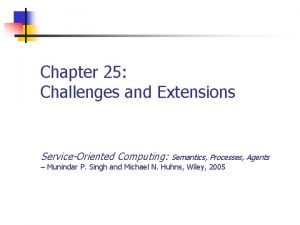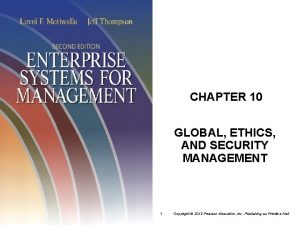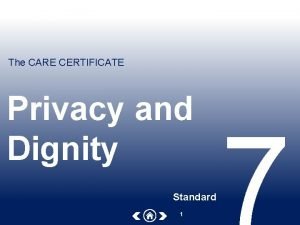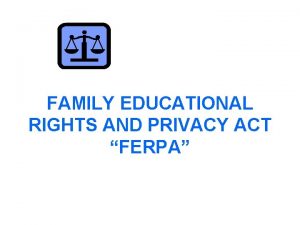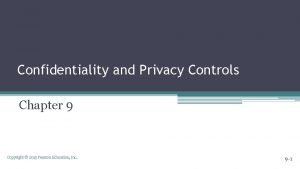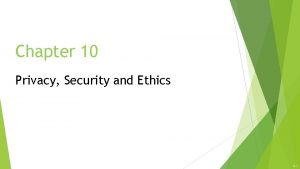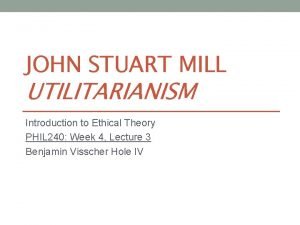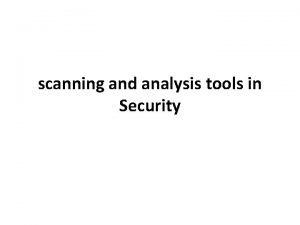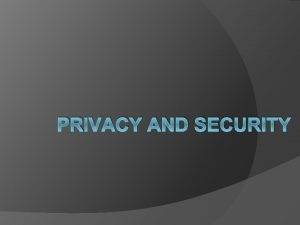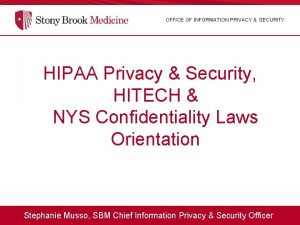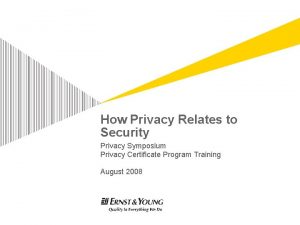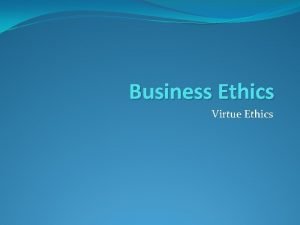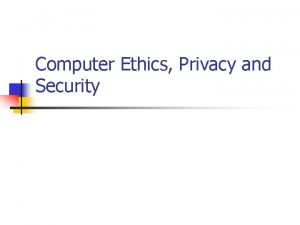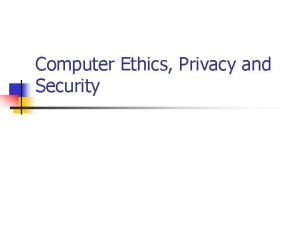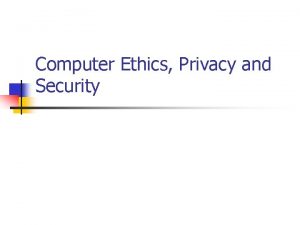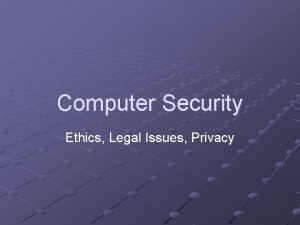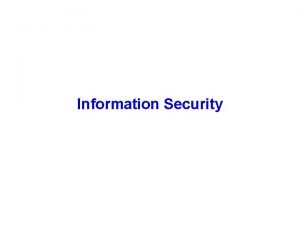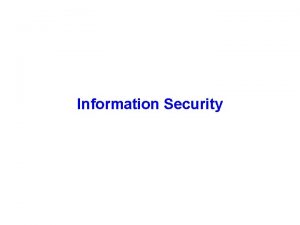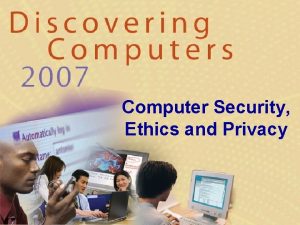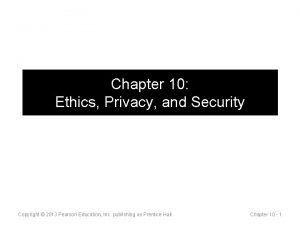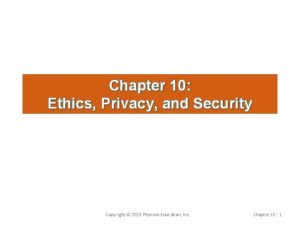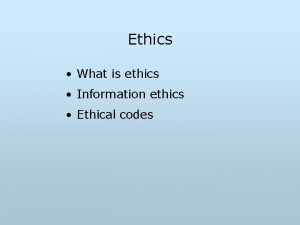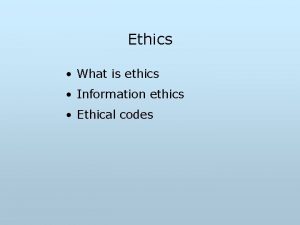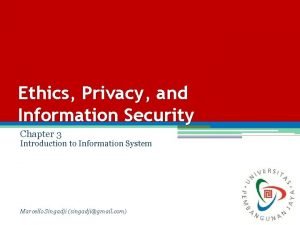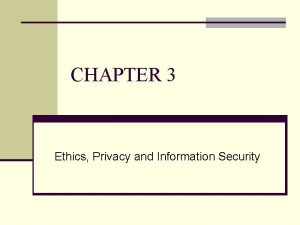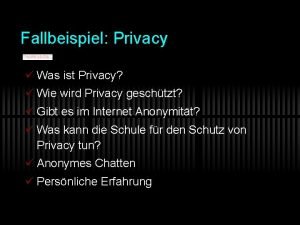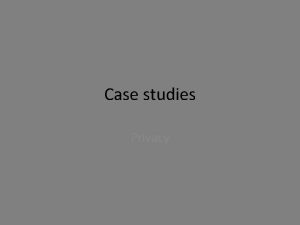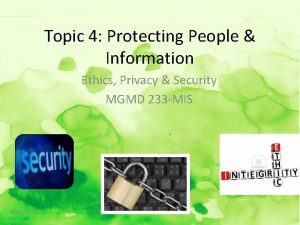Ethics Privacy and Information Security Copyright 2007 John





































- Slides: 37

Ethics, Privacy and Information Security Copyright 2007 John Wiley & Sons, Inc. Chapter 3 1

Outline w 3. 1 Ethical Issues w 3. 2 Threats to Information Security w 3. 3 Protecting Information Resources Copyright 2007 John Wiley & Sons, Inc. Chapter 3 2

Learning Objectives w Describe the major ethical issues related to information technology and identify situations in which they occur. w Describe the many threats to information security. w Understand the various defense mechanisms used to protect information systems. w Explain IT auditing and planning for disaster recovery. Copyright 2007 John Wiley & Sons, Inc. Chapter 3 3

Ethical Issues w Ethics. A branch of philosophy that deals with what is considered to be right and wrong. w A Code of Ethics is a collection of principles that are intended to guide decision making by members of an organization. Copyright 2007 John Wiley & Sons, Inc. Chapter 3 4

The Four Categories of Ethical Issues w Privacy Issues involves collecting, storing and disseminating information about individuals. w Accuracy Issues involves the authenticity, fidelity and accuracy of information that is collected and processed. w Property Issues involves the ownership and value of information. w Accessibility Issues revolve around who should have access to information and whether they should have to pay for this access. Copyright 2007 John Wiley & Sons, Inc. Chapter 3 5

Protecting Privacy w Privacy. The right to be left alone and to be free of unreasonable personal intrusions. w Two rules have been followed fairly closely in past court decision in many countries: § The right of privacy is not absolutes. Privacy must be balanced against the needs of society § The public’s right to know is superior to the individual’s right of privacy. Copyright 2007 John Wiley & Sons, Inc. Chapter 3 6

Protecting Privacy (Continued) w Electronic Surveillance. The tracking of people‘s activities, online or offline, with the aid of computers. w Personal Information in Databases. Information about individuals is being kept in many databases: banks, utilities co. , govt. agencies, …etc. ; the most visible locations are credit-reporting agencies. Copyright 2007 John Wiley & Sons, Inc. Chapter 3 7

Protecting Privacy (Continued) w Information on Internet Bulletin Boards and Newsgroups. Electronic discussions such as chat rooms and these other sites appear on the Internet, within corporate intranets, and on blogs. w A blog (Weblog) is an informal, personal journal that is frequently updated and intended for general public reading. Copyright 2007 John Wiley & Sons, Inc. Chapter 3 8

Protecting Privacy (Continued) w Privacy Codes and Policies. An organization’s guidelines with respect to protecting the privacy of customers, clients, and employees. w International Aspects of Privacy issues that international organizations and governments face when information spans countries and jurisdictions. Copyright 2007 John Wiley & Sons, Inc. Chapter 3 9

Threats to Information Security w A threat to an information resource is any danger to which a system may be exposed. w The exposure of an information resources is the harm, loss or damage that can result if a threat compromises that resource. w A system’s vulnerability is the possibility that the system will suffer harm by a threat. w Risk is the likelihood that a threat will occur. w Information system controls are the procedures, devices, or software aimed at preventing a compromise to the system. Copyright 2007 John Wiley & Sons, Inc. Chapter 3 10

Unintentional Threats w Human errors can occur in the design of the hardware and/or information system. w Also can occur in programming, testing, data collection, data entry, authorization and procedures. w Contribute to more than 50% of control and security-related problems in organizations. Copyright 2007 John Wiley & Sons, Inc. Chapter 3 11

Unintentional Threats (Continued) w Environmental hazards include earthquakes, severe storms, floods, power failures or strong fluctuations, fires (most common hazard), explosions, …etc. w Computer system failures can occur as the result of poor manufacturing or defective materials. Copyright 2007 John Wiley & Sons, Inc. Chapter 3 12

Intentional Threats w Typically, criminal in nature. w Cybercrimes are fraudulent activities committed using computers and communications networks, particularly the Internet. w Average cybercrime involves about $600, 000 according to FBI. Copyright 2007 John Wiley & Sons, Inc. Chapter 3 13

Intentional Threats (Continued) w Hacker. An outside person who has penetrated a computer system, usually with no criminal intent. w Cracker. A malicious hacker. w Social engineering. Computer criminals or corporate spies get around security systems by building an inappropriate trust relationship with insiders. Copyright 2007 John Wiley & Sons, Inc. Chapter 3 14

Espionage or Trespass w The act of gaining access to the information an organization is trying to protect by an unauthorized individual. w Industrial espionage occurs in areas where researching information about the competition goes beyond the legal limits. w Governments practice industrial espionage against companies in other countries. w Shoulder surfing is looking at a computer monitor or ATM screen over another person’s shoulder. Copyright 2007 John Wiley & Sons, Inc. Chapter 3 15

Information Extortion w When an attacker or formerly trusted employee steal information from a computer system and then demands compensation for its return or an agreement not to disclose it. Copyright 2007 John Wiley & Sons, Inc. Chapter 3 16

Sabotage or Vandalism w A popular type of online vandalism is hacktivist or cyber-activist activities. w Hack-tivist or cyber-activist use technology for high-tech civil disobedience to protest operations, policies, or actions of an individual, an organization, or a government agency. Copyright 2007 John Wiley & Sons, Inc. Chapter 3 17

Sabotage or Vandalism (Continued) w Cyber-terrorism is a premeditated, politically motivated attack against information, computer systems, computer programs, and data that results in violence against noncombatant targets by subnational groups or clandestine agents. w Cyber-war. War in which a country’s information systems could be paralyzed from a massive attack by destructive software. w Theft is the illegal taking of property that belongs to another individual or organization. Copyright 2007 John Wiley & Sons, Inc. Chapter 3 18

Identity Theft w Crime in which someone uses the personal information of others, usually obtained from the Internet, to create a false identity and then commits fraud. w Fastest growing white-collar crime. w Biggest problem is restoring victim’s damaged credit rating. Copyright 2007 John Wiley & Sons, Inc. Chapter 3 19

Software Attacks w Malicious software (malware) designed to damage, destroy, or deny service to the targeted systems. w Most common types of software attacks are viruses, worms, Trojan horses, logic bombs, back doors, denial-of-service, alien software, phishing and pharming. Copyright 2007 John Wiley & Sons, Inc. Chapter 3 20

Software Attacks (Continued) w Viruses. Segments of computer code that performs unintended actions ranging from merely annoying to destructive. w Worms. Destructive programs that replicate themselves without requiring another program to provide a safe environment for replication. w Trojan horses. Software programs that hide in other computer programs and reveal their designed behavior only when they are activated. Copyright 2007 John Wiley & Sons, Inc. Chapter 3 21

Software Attacks (Continued) w Logic bombs. Designed to activate and perform a destructive action at a certain time. w Back doors or trap doors. Typically a password, known only to the attacker, that allows access to the system without having to go through any security. w Denial-of-service. An attacker sends so many information requests to a target system that the target cannot handle them successfully and can crash the entire system. Copyright 2007 John Wiley & Sons, Inc. Chapter 3 22

Alien Software w Pestware. Clandestine software that uses up valuable system resources and can report on your Web surfing habits and other personal information. w Adware. Designed to help pop-up advertisements appear on your screen. w Spyware. Software that gathers user information through the user’s Internet connection without their knowledge (i. e. key logger, password capture). Copyright 2007 John Wiley & Sons, Inc. Chapter 3 23

Alien Software (Continued) w Spamware. Designed to use your computer as a launch pad for spammers. w Spam. Unsolicited e-mail, usually for purposes of advertising. w Cookies. Small amount of information that Web sites store on your computer, temporarily or more-or-less permanently. Copyright 2007 John Wiley & Sons, Inc. Chapter 3 24

Alien Software (Continued) w Web bugs. Small, usually invisible, graphic images that are added to a Web page or e-mail. w Phishing. Uses deception to fraudulently acquire sensitive personal information such as account numbers and passwords disguised as an officiallooking e-mail. w Pharming. Fraudulently acquires the Domain Name for a company’s Web site and when people type in the Web site url they are redirected to a fake Web site. Copyright 2007 John Wiley & Sons, Inc. Chapter 3 25

Compromises to Intellectual Property w Intellectual property. Property created by individuals or corporations which is protected under trade secret, patent, and copyright laws. w Trade secret. Intellectual work, such as a business plan, that is a company secret and is not based on public information. w Patent. Document that grants the holder exclusive rights on an invention or process for 20 years. Copyright 2007 John Wiley & Sons, Inc. Chapter 3 26

Compromises to Intellectual Property (Continued) w Copyright. Statutory grant that provides creators of intellectual property with ownership of the property for life of the creator plus 70 years. w Piracy. Copying a software program without making payment to the owner. Copyright 2007 John Wiley & Sons, Inc. Chapter 3 27

Protecting Information Resources w Risk. The probability that a threat will impact an information resource. w Risk management. To identify, control and minimize the impact of threats. w Risk analysis. To assess the value of each asset being protected, estimate the probability it might be compromised, and compare the probable costs of it being compromised with the cost of protecting it. Copyright 2007 John Wiley & Sons, Inc. Chapter 3 28

Protecting Information Resources (Continued) w Risk mitigation is when the organization takes concrete actions against risk. It has two functions: n n (1) implement controls to prevent identified threats from occurring, and (2) developing a means of recovery should the threat become a reality. Copyright 2007 John Wiley & Sons, Inc. Chapter 3 29

Risk Mitigation Strategies w Risk Acceptance. Accept the potential risk, continue operating with no controls, and absorb any damages that occur. w Risk limitation. Limit the risk by implementing controls that minimize the impact of threat. w Risk transference. Transfer the risk by using other means to compensate for the loss, such as purchasing insurance. Copyright 2007 John Wiley & Sons, Inc. Chapter 3 30

Controls w Controls evaluation. Identifies security deficiencies and calculates the costs of implementing adequate control measures. w General controls. Established to protect the system regardless of their application. n n Physical controls. Physical protection of computer facilities and resources. Access controls. Restriction of unauthorized user access to computer resources; use biometrics and passwords controls for user identification. Copyright 2007 John Wiley & Sons, Inc. Chapter 3 31

Controls (Continued) w Communications (networks) controls. To protect the movement of data across networks and include border security controls, authentication and authorization. n n Firewalls. System that enforces access-control policy between two networks. Encryption. Process of converting an original message into a form that cannot be read by anyone except the intended receiver. Copyright 2007 John Wiley & Sons, Inc. Chapter 3 32

Controls (Continued) w All encryption systems use a key. w Symmetric encryption. Sender and the recipient use the same key. w Public-key encryption. Uses two different keys: a public key and a private key. w Certificate authority. Asserts that each computer is identified accurately and provides the public keys to each computer. Copyright 2007 John Wiley & Sons, Inc. Chapter 3 33

Controls (Continued) w Virtual Private Networking. Uses the Internet to carry information within a company and among business partners but with increased security by uses of encryption, authentication and access control. w Application controls. Controls that protect specific applications and include: input, processing and output controls. Copyright 2007 John Wiley & Sons, Inc. Chapter 3 34

Controls (Continued) w Information systems auditing. Independent or unbiased observers task to ensure that information systems work properly. w Types of Auditors and Audits n n n Internal. Performed by corporate internal auditors. External. Reviews internal audit as well as the inputs, processing and outputs of information systems. Audit. Examination of information systems, their inputs, outputs and processing. Copyright 2007 John Wiley & Sons, Inc. Chapter 3 35

IS Auditing Procedure w Auditing around the computer means verifying processing by checking for known outputs or specific inputs. w Auditing through the computer means inputs, outputs and processing are checked. w Auditing with the computer means using a combination of client data, auditor software, and client and auditor hardware. Copyright 2007 John Wiley & Sons, Inc. Chapter 3 36

Disaster Recovery Planning w Disaster recovery. The chain of events linking planning to protection to recovery, disaster recovery plan. w Disaster avoidance. Oriented towards prevention, uninterrupted power supply (UPS). w Hot sites. External data center that is fully configured and has copies of the organization’s data and programs. Copyright 2007 John Wiley & Sons, Inc. Chapter 3 37
 Chapter 9 privacy security and ethics
Chapter 9 privacy security and ethics Chapter 9 privacy security and ethics
Chapter 9 privacy security and ethics Chapter 9 privacy security and ethics
Chapter 9 privacy security and ethics What is the destructive event or prank the virus delivers
What is the destructive event or prank the virus delivers Privacy awareness and hipaa privacy training cvs answers
Privacy awareness and hipaa privacy training cvs answers Ethical and professional issues in information security
Ethical and professional issues in information security Microsoft from back doors patch gov
Microsoft from back doors patch gov Hipaa privacy and security awareness training
Hipaa privacy and security awareness training Private securit
Private securit Copyright 2007
Copyright 2007 Pearson
Pearson Visa international security model in information security
Visa international security model in information security Cnss security model
Cnss security model Social issues in information technology
Social issues in information technology âq1
âq1 Us digital millennium copyright act autumn
Us digital millennium copyright act autumn What is micro-ethics
What is micro-ethics Ethique quiz
Ethique quiz Descriptive ethics
Descriptive ethics Normative ethical questions
Normative ethical questions Descriptive ethics vs normative ethics
Descriptive ethics vs normative ethics Metaethics vs normative ethics
Metaethics vs normative ethics Descriptive ethics vs normative ethics
Descriptive ethics vs normative ethics Beneficence examples
Beneficence examples Metaethics vs normative ethics
Metaethics vs normative ethics Branches of metaethics
Branches of metaethics Example of deontology
Example of deontology Teleological ethics vs deontological ethics
Teleological ethics vs deontological ethics Wireless security in cryptography and network security
Wireless security in cryptography and network security Electronic commerce security
Electronic commerce security With erp implementations why would an auditorget involved
With erp implementations why would an auditorget involved Care certificate 7
Care certificate 7 Family educational rights and privacy act 1974
Family educational rights and privacy act 1974 Family educational rights and privacy act of 1974
Family educational rights and privacy act of 1974 Confidentiality and privacy controls
Confidentiality and privacy controls Three primary privacy issues are accuracy property and
Three primary privacy issues are accuracy property and Hedonism and utilitarianism
Hedonism and utilitarianism Scanning and analysis tools
Scanning and analysis tools
